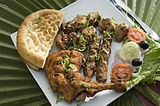キール
Kheer/ja
 キールのボウル | |
| Alternative names | クシーラム、ドゥードゥパック、ミータ・バット(マヤサムと誤解されることもある) |
|---|---|
| Type | プディング |
| Course | デザート |
| Place of origin | 古代インド |
| Main ingredients | 米、牛乳、砂糖、カルダモン、ジャガリー、サフラン、ピスタチオまたはアーモンド |
| Variations | ヴァーミセリ(セマイヤ)キール、大麦キール、カッドゥ・キ・キール、パール(ミルク)、パヤサム、パイェシュ、チャナー・パイェシュ(チャナーまたはパニールで作られたパイェシュ) |
| 249 kcal (1043 kJ) | |
キール(Kheer)、khir、またはパヤサムは、インド亜大陸で人気のプディングまたはポリッジ(特にライスプディング)で、通常は牛乳、砂糖またはジャガリー、米を煮て作られる。ドライフルーツ、ナッツ、カルダモン、サフランで風味を付け加えることもある。米の代わりに、挽き割り小麦、ヴァーミセリ(セバイ)、サゴ、またはタピオカ(サゴデンプン)を含むこともある。
北インドでは、様々な方法で作られる。最も人気のあるものは、米とヴァーミセリ(セマイヤ)で作られるものである。
語源
kheerという言葉は、サンスクリット語の「クシラ」(क्षीर)に由来し、これは牛乳または牛乳ベースの料理を意味する。キールは、甘いライスプディングの古風な名称でもある。 南インドでキールを指すpayasamという言葉は、サンスクリット語の「pāyasa」(पायस)に由来し、「牛乳」または牛乳で作られた料理を意味する。この用語は、マラヤーラム語(പായസം, pāyasaṁ)、テルグ語(పాయసం, pāyasaṁ)、タミル語(பாயசம், pāyacam)など、様々な地方言語に発展した。
起源
It is said to have originated initially in South India thousands of years ago. The story is titled "The Legend of Chessboard" in Kerala, an old sage in the form of Krishna challenged the king of Ambalapuzha (chess enthusiasts) to play chess. To motivate the sage, the king offered anything that the sage would name. The sage modestly asked just for a few grains of rice but under one condition: the king has to put a single grain of rice on the first chess square and double it on every subsequent one.
Lord Krishna (the sage) won the game and the king started placing the grains. As he stacked them, he was shocked to see the number grow exponentially. In the end, the number came up to trillions. Krishna reveals himself and asks the king to provide kheer to every pilgrim who comes to his temple there. The Ambalapuzha Krishna temple still follows this and it is located in Kerala's Alappuzha district.
According to the food historian K. T. Achaya, kheer or payasam, as it is known in southern India, was a popular dish in ancient India. First mentioned in ancient Indian literature, it was a mixture of rice, milk and sugar, a formula that has endured for over two thousand years. Payasam was also a staple Hindu temple food, in particular, and it is served as Prasāda to devotees in temples.
ギャラリー
-
ドライフルーツとナッツをトッピングしたキール
-
キール
-
パール・パヤサム
-
ヴァーミセリ入りキール(セヴィヤン・キール、セミヤ・パヤサム、またはシェマイと呼ばれる)
-
ヴァーミセリ・キール
関連項目
- ポリッジ
- フィルニ – 粉米または米粉を牛乳で煮て冷やして食べるデザート
- シール・ベレンジュ – ペルシャのライスプディング
- ドゥードゥパック – グジャラートのライスプディング
- シェマイ – ベンガルのヴァーミセリプディング
- シール・クルマ – ペルシャのヴァーミセリプディング
| この記事は、クリエイティブ・コモンズ・表示・継承ライセンス3.0のもとで公表されたウィキペディアの項目Kheer(13 July 2025, at 09:46編集記事参照)を翻訳して二次利用しています。 |
- Pakistani rice dishes
- Bangladeshi rice dishes
- Indian rice dishes
- North Indian cuisine
- Muhajir cuisine
- Bihari cuisine
- Uttar Pradeshi cuisine
- Indian desserts
- Nepalese cuisine
- Bangladeshi desserts
- Cuisine of Odisha
- Rice pudding
- Telangana cuisine
- Hyderabadi cuisine
- Punjabi cuisine
- Fijian desserts
- Kerala cuisine
- Tamil cuisine
- Indian cuisine
- Pakistani cuisine
- Sri Lankan cuisine
- Indo-Caribbean cuisine





